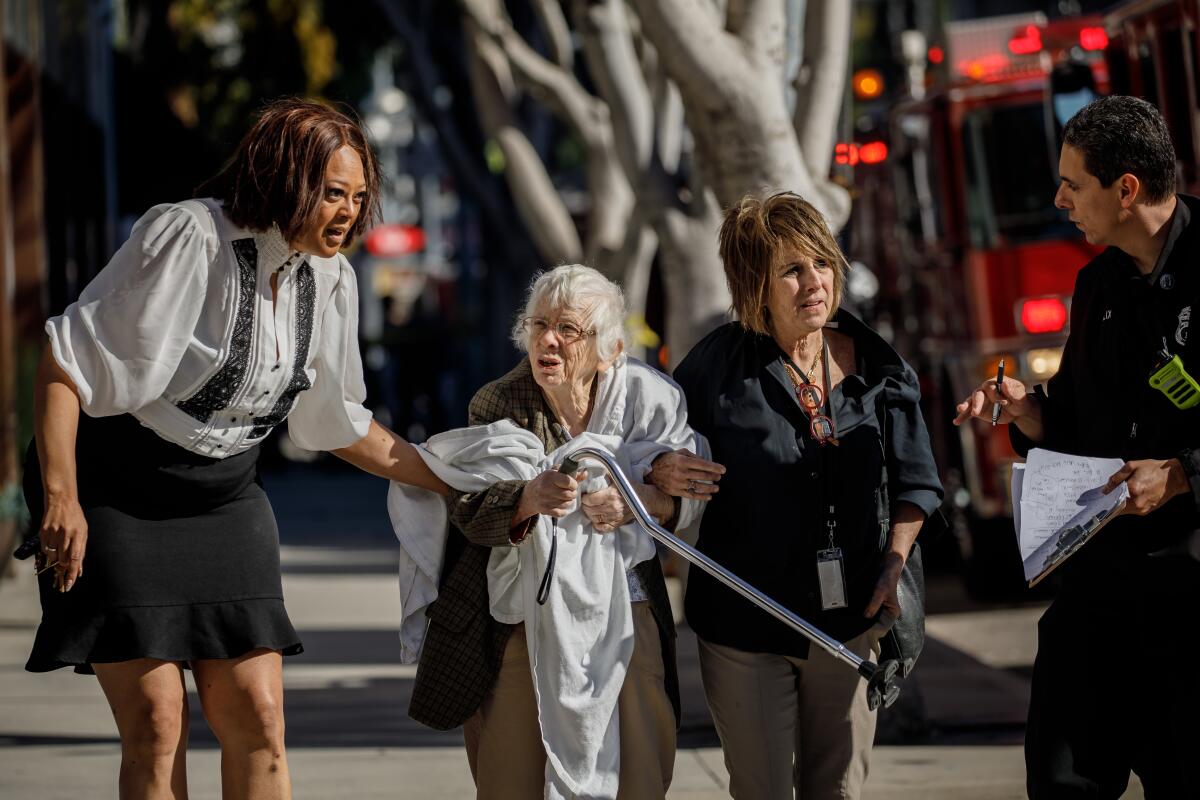L.A. politicians want fire sprinklers in all apartment towers after Westside fire

- Share via
Days after a fire scorched a Westside high-rise and left more than a dozen people injured, several members of the Los Angeles City Council called Friday to mandate sprinkler systems in all residential towers across the city.
Sprinklers are required in most apartment buildings, but the city has maintained an exemption for high-rises built between 1943 and 1974 — a loophole that council members called “dangerous” in their new proposal.
L.A. officials have identified 55 buildings from that era that lack sprinklers, including Barrington Plaza, which ignited this week. The same Wilshire Boulevard building had already gone up in flames in 2013 and in 1971, a fact that galled politicians and residents.
Councilman Mike Bonin, whose district includes Barrington Plaza, said that mandating sprinklers in all residential high-rises was a “basic, common-sense public safety measure.”
Firefighters did heroic work at the building, Bonin said in a statement, “but the spread of the fire could have been halted by a fire sprinkler system, preventing further damage to the building, injury to tenants, and risk to LAFD firefighters.”
Under the proposal introduced by councilmen Bonin, Paul Koretz and Bob Blumenfield and seconded by Councilwoman Monica Rodriguez, apartment and condominium towers that have been exempt from the sprinkler requirements would have to be retrofitted. The idea now heads to a committee for further review.
This isn’t the first time the idea has arisen at City Hall. More than two years ago, Koretz and Councilman David Ryu asked city staffers to report on steps toward retrofitting buildings with sprinklers. During a committee meeting over a year ago, then-Councilman Mitchell Englander called it a good idea but raised concerns about costs and other obstacles.
“It’s a great idea on paper … but as policymakers, we have to also look at the reality,” Englander said. “Because it’s not just a matter of, ‘Do everything we possibly can, at any cost, on somebody else’s back.’ … If it’s not feasible, we’ve got a problem.”
The committee opted to “note and file” the report, instead of approving its recommendations. Englander said that wouldn’t end the discussion but that council members needed to craft a comprehensive plan involving all the groups that would be affected.
At the time, Councilman Mitch O’Farrell balked at the move, saying, “The way to keep a discussion going is to not kill an item in committee.”
In its report 2½ years ago, L.A.’s Fire Prevention Bureau estimated that such retrofits would cost an average of $6,000 per unit or $1.6 million for a 16-story high-rise, and would average three years to complete. During the committee meeting, Fire Department officials said that since 1979, there had been eight fatalities in buildings exempt from the sprinkler requirements.
The National Fire Protection Assn. recommends that all existing and new high-rise residential buildings have sprinkler systems to protect residents against blazes — a set of guidelines that have been in place for decades, said Robert Solomon, a fire protection engineer with the nonprofit.
Solomon said that high-rise fires often spark debates about retrofitting, but questions about who will pay can sometimes stymie action. “Unless a series of these fires occur in a sequence, most of the cities go back to business as usual,” Solomon said.
Englander, who now works as president of the government relations group E-Venture, said he was glad the idea was surfacing again. “They should seize that moment and come up with a balanced approach where it’s not a cost burden,” he said, suggesting a tax incentive for building owners as one possibility.
In their motion, Bonin, Koretz, and Blumenfield asked to explore the idea of getting federal loans, housing revenue bonds, and other state and local funds to help building owners cover the costs of required retrofits.
Meanwhile, residents began trickling back into Barrington Plaza, with many allowed to return Thursday night. But some parts of the apartments on Wilshire Boulevard closest to where the blaze erupted could be accessed only with restrictions or remained entirely off-limits to residents for the time being.
The fire began about 8:30 a.m. Wednesday and spread quickly through the sixth and seventh floors of the 270-unit Building A in the sprawling, three-tower development. Thirteen people were injured.
Times staff writer Dakota Smith contributed to this report.
More to Read
Sign up for Essential California
The most important California stories and recommendations in your inbox every morning.
You may occasionally receive promotional content from the Los Angeles Times.















